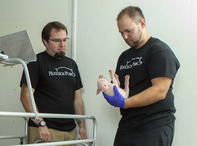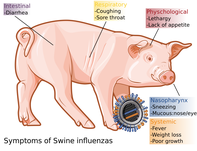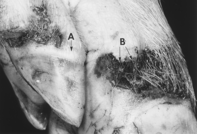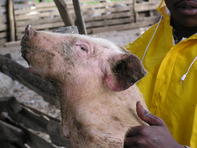There are many diseases and parasites that affect pigs, some more serious than others. Some are transmissible to man, some are shared with other mammals and birds, some are everywhere in similar forms.

It is useful for the small-herd pig producer to be able to recognise the presence of really destructive and contagious infections. It is also important to know where to seek professional help and to be able to describe what symptoms are being shown by the animal or what abnormalities can be seen in an animal that has died. This article will deal with some of the signs that sick animals will show while living and which should be reported to the nearest state veterinary officer.
What is Swine Fever?

Two very similar virus infections are African Swine Fever (ASF) and European Swine Fever. European Swine Fever is also known as Classical Swine Fever (CSF) or as Hog Cholera in the US.
The swine fever diseases belong to the group of haemorrhagic fevers (fevers associated with flu-like symptoms and bleeding) which include Ebola and Marburg virus disease and some similar human virus infections. All these fevers have the same clinical picture: they spread very rapidly, almost everything and everyone in contact get infected and a high percentage of victims die.
Symptoms of Swine Fever
Both ASF and CSF follow the same pattern. Symptoms include a high fever and bleeding under the skin and into vital organs, evidence of pain which is followed by collapse and death within days.
Carcasses remain infective for weeks. Warthogs in the infected areas may carry the ASF virus for long periods and distribute infected soft ticks, which act as carriers. Humans do not catch ASF or CSF.
The pig farmer will be alerted by a sudden rise in deaths in the herd, often after a new introduction, or if there are known to be warthogs in the infected area, mostly in the Limpopo Province, parts of Mpumalanga and the northern tip of KwaZulu-Natal in South Africa.
ASF is widespread in Central and West Africa and has spread to much of Europe and now also Asia. CSF was present as an exotic disease some years ago in Eastern Cape and was eventually eliminated at great cost.
What is Foot and Mouth Disease?
Foot and Mouth Disease (FMD) is a rapidly spreading infection that every pig farmer hears about and fears. An added hazard for farmers is that it affects a wide range of animals, including all the antelope species and buffalo, domestic ruminants (cattle, goats, sheep) and pigs. It is also present in a well-isolated and demarcated area in the north-east corner adjacent to the Kruger National Park.Foot and Mouth Disease in Pigs

Pigs are severely affected by FMD. This disease can cause heavy mortality in young piglets. Older pigs that survive, act as massive multipliers of the virus and excrete millions of virus particles for months. The disease in the larger ruminants seldom causes deaths except in very young pigs.
The main symptoms of foot and mouth disease are fever - shown by a loss of appetite and small blisters in the mouth and muzzle, which make eating difficult. Similar blisters occur on the upper rim of the hoof, making walking painful. It often follows that the whole tough outer covering of the foot comes away, leaving the tender inner hoof exposed; again a painful handicap to moving.
The harm done by FMD is financial: production is hugely affected by the loss of growth of animals, reduction in milk, death of animals and the long periods of export embargoes placed on all possibly contaminated produce, even fruit and vegetables.
Porcine Reproductive and Respiratory Syndrome (PRRS)

Treatment of Pig Diseases
There is no treatment such as antibiotics for these virus diseases. Both are ‘controlled diseases’ in terms of the Animal Health Act. This means that any suspicion of an outbreak must be reported to the State Veterinarian and the control measures will be in the hands of Government as soon as the disease is confirmed. There is no vaccine for ASF, and none is being planned at this stage.
Even good vaccines can leave surviving animals that carry the virus without showing symptoms. Periodic shedding of ASF virus can start another outbreak Vaccines exist for FMD and are often used together with quarantine and isolation within an infected area.
Where necessary, the government may cull all foot-and-mouth disease infected and contact animals then destroy the carcasses as the only effective way of destroying the virus. Please note: Information is for educational and informational purposes only and may not be construed as medical advice. The information is not intended to replace medical advice or treatment offered by your veterinarian.
By Dr Jim Robinson